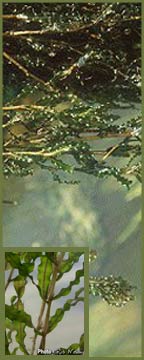Curly Leaf Pondweed
 Potomogeton crispus
Potomogeton crispus
Curly Leaf Pond Weed is a submersed perennial aquatic plant native to Eurasia, Africa, and Australia introduced into North America about the mid 1800s. It displaces native plants and reduces overall biological diversity by forming dense mats of vegetation in the water.
Curly Leaf Pond Weed has naturalized throughout most of North America however has not yet been reported or confirmed in Manitoba. It is, however, found throughout most of the United States, including areas of North Dakota and Minnesota along the Manitoba border.
Description - Curly Leaf Pondweed
General: May grow in depths of up to 5 meters in freshwater lakes, ponds and wetlands. Plants grow quickly in the spring and die back mid July.
Leaves: Submersed, curly with finely toothed margins, reddish green, alternate, oblong, and attached directly to stem.
Stem: The stems may be up to 1 meter long and are somewhat flattened.
Flowers: Whitish, tiny, and have 4 petal-like lobes found on spikes raised above the water along the stalk.
Habitat
Curly Leaf Pond Weed is generally found in ponds, rivers, lakes, wetlands, streams and brackish waters. The plant tolerates low light and temperatures and prefers nutrient-rich habitats.
Dispersal
The plant spreads primarily by winter buds called turions. Turions are hard, dark green/brown, about 2 cm long and 1 cm wide, and produced at the tips of lateral branches. One plant may produce hundreds of turions that fall to the ground, overwinter and germinate the next spring. Seeds play a small role in reproduction if any.
Curly leaf pondweed is most likely spread overland by recreational boating as the plant wraps around propellers. It is currently sold widely in pet shops and via the Internet as an aquarium plant. Individuals frequently discard aquarium plants into nearby retention ponds and rivers thus contributing to dispersal.
Impacts
Curly Leaf Pond Weed has an advantage over our native plants in that it begins growing earlier than most native aquatic plants, winning valuable resources. Dense mats shade out native submerged species, reduce biological diversity, and impede recreational activities including boating and swimming. When Curly Leaf Pond Weed dies back in mid summer, the dead plant materials gather along shorelines and are often followed by undesirable algal blooms from the release of phosphorus.
Control Methods
Management strategies have included herbicides, mechanical harvesting, hand pulling, and winter water drawdowns. In Minnesota, management includes a multifaceted public awareness effort with radio and newspaper advertising, boat washing programs, and invasive species displays. Control methods have included whole lake herbicide treatments which would not be permitted in Canada. Pulling and cutting can help reduce biomass however is not selective and is very time and labor intensive. Benthic barriers have been used in areas such as swimming beaches, boating lanes and around docks to restrict light and upward growth.
Resources
Curly Leaf Pondweed ISCM Fact Sheet
Curly Leaf Pondweed — Project Fact Sheet
Â
Back to Aquatic Invasive Species List
Â

